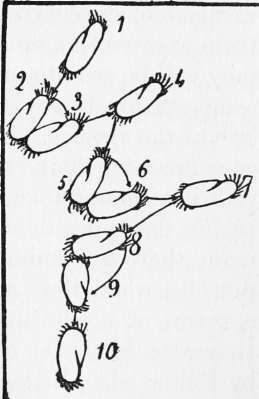Chapter V. Differential Sensitiveness-Species Memory, And Simulation Of Death. The Theory Of Trial And Error
Description
This section is from the book "The Psychic Life Of Insects", by E. L. Bouvier. Also available from Amazon: The Psychic Life of Insects.
Chapter V. Differential Sensitiveness-Species Memory, And Simulation Of Death. The Theory Of Trial And Error
The numerous and interesting experiments carried on by Jennings1 to justify the theory of trial and error furnish striking examples of the combination of tropisms with the phenomena of differential sensitiveness. We think that it will be of use to note the following, which are among the most typical. The Infusoria of the «pecies Oxytricha fallax are placed in water in a basin warmed at one end, x, (Figure 3) ; an individual starts toward the warm part, -arrives at 1, recoils 2, turns to the right 3, from the effect of differential sensitiveness, then, returning not quite so far toward x, finds itself again in the warm part 4, which produces a second recoil 5, and a second turn to the right 6. The same phenomena are reproduced at 8 and 9, leading the infusorian more and more from the warm part, while it swims or moves directly into the cold part 10. As we have just shown after Bohn, there is a combination of negative thermotropism with a differential sensitiveness to the heat.
1 H. S. Jennings, Contributions to a Study of the Behavior of the Lower Organisms, 1904. (Carnegie Institution of Washington Pub. No. 16).
This is evidently the explanation of these phenomena: the animal obeys the three simple laws which we have explained. But to Jennings, the behavior of Oxyiricka fallax and lower organisms to external stimuli is the result of a series of trials. When these organisms, he says, "receive a stimulus which provokes a response, they try to go in different directions. If the direction followed leads them to a new stimulus, they try another, until the one found leads them to a proper stimulus." In other words, the animal makes a series of trials which correct the first errors, until a satisfactory result is reached. This is the theory of "trial and error," formulated by Lloyd Morgan after his work on the higher vertebrates. Jennings recalls, apropos of this, numerous experiments, fruitless at first, in which Morgan's dog tried to pass through the narrow opening in a barrier, his master's cane in his mouth: "Just as the dog for the first time carried the cane in his mouth across the opening in the barrier," the lower organisms "seek in all directions until one of them is found practicable. . . . The problem is the same for the dog as for the lower organisms." With the one as well as with the other, it is necessary to consider as an "error" everything which produces a physiological state analogous to that which in men is characterized by a sensation of pain; after a trial, the organisms avoid what produces with them a condition of this kind.
It is difficult to dispute this analogy, for we know nothing of the sensations of pain or of pleasure which these organisms feel, especially the lower organisms, but what strengthens Jenning's theory is that the protoplasm has a primitive power of reaction against external stimulants (which is undoubted) and that lower animals are capable of making a choice between these reactions to direct themselves in ways which are favorable to them. So the advances, the turnings, and the recoils which are for us simple automatic responses of trop-isms and of differential sensitiveness, represent to Jennings a sort of actual apprenticeship.

Fig. 3.-Movements of Oxytricha fallow in a beaker of water of which the wall x is warmed. (After Jennings).
If this be so, it follows that this apprenticeship is singularly long and only slightly fruitful with the organisms which undergo it. In all the insects which we have studied from this point of view, as in Oxytriciia fallax, the reactions produced by variations of intensity with stimuli are invariable, stereotyped, so to say, and inseparable from organic function. We notice them to-day as they will be seen to-morrow, and it is certainly no exaggeration to say that they go back to the origin of the species. If the Oxytrichas are capable of correcting their errors by trials, why do they return without pause to the warm side before once trying the opposite side of the aquarium? Moreover, there are animals which orient themselves directly when they are young and afterward by a series of oscillations due to differential sensitiveness ; this is the case with the starfish studied by Bohn ; when little, they go straight to dark or light surfaces; when older, they behave like the Oxytricha fallax, so that they end where they would have begun if they had really obeyed Jennings's law.
Continue to:
- prev: Combination Of Differential Sensitiveness With The Tropisms
- Table of Contents
- next: Possible Adaptation Of Differential Sensitiveness
